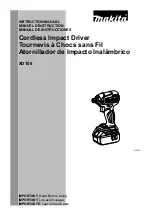
PDSSAP 20-Li B3
GB
│
IE
│
5
■
g)
If devices are provided for the connection of
dust extraction and collection facilities, ensure
these are connected and properly used.
Use
of dust collection can reduce dust-related
hazards.
h)
Do not allow yourself to get lulled into a false
sense of security and do not ignore the safety
rules for power tools, even if you are familiar
with the power tool after repeated use.
A care-
less action can cause severe injury within a frac-
tion of a second.
4. Power tool use and care
a)
Do not force the power tool. Use the correct
power tool for your application.
The correct
power tool will do the job better and safer at the
rate for which it was designed.
b)
Do not use the power tool if the switch does
not turn it on and off.
Any power tool that
cannot be controlled with the switch is
dangerous and must be repaired.
c)
Disconnect the plug from the power source
and/or remove the battery pack, if detach-
able, from the power tool before making any
adjustments, changing accessories, or storing
power tools.
Such preventive safety measures
reduce the risk of starting the power tool acci-
dentally.
d)
Store idle power tools out of the reach of
children and do not allow persons unfamiliar
with the power tool or these instructions to
operate the power tool.
Power tools are
dangerous in the hands of untrained users.
e)
Maintain power tools and accessories. Check
for misalignment or binding of moving parts,
breakage of parts and any other condition
that may affect the power tool’s operation. If
damaged, have the power tool repaired
before use.
Many accidents are caused by
poorly maintained power tools.
f)
Keep cutting tools sharp and clean.
Properly
maintained cutting tools with sharp cutting
edges are less likely to bind and are easier to
control.
g)
Use the power tool, accessories and acces-
sory tools etc. in accordance with these
instructions, taking into account the working
conditions and the work to be performed.
Using power tools for operations different from
those intended can result in hazardous situa-
tions.
h)
Keep handles and grasping surfaces dry,
clean and free from oil and grease.
Slippery
handles and grasping surfaces do not allow for
safe handling and control of the tool in unex-
pected situations.
5. Use and handling of the cordless
electrical power tool
a)
Charge a rechargeable battery using only
the charger recommended by the manufac-
turer.
Chargers are often designed for a
particular type of rechargeable battery unit.
There is a risk of fire if other types of recharge-
able battery units are used.
b)
Only the rechargeable battery units supplied
are to be used with an electrical power tool.
The use of other rechargeable battery units may
lead to the danger of injury or fire.
c)
When they are not being used, store
rechargeable battery units away from paper-
clips, coins, keys, nails, screws or other small
metal objects that could cause the contacts to
be bridged.
Short-circuiting the contacts of a
rechargeable battery unit may result in heat
damage or fire.
d)
Fluids may leak out of rechargeable battery
units if they are misused. If this happens,
avoid contact with the fluid. If contact occurs,
flush the affected area with water. Seek addi-
tional medical help if any of the fluid gets into
your eyes.
Escaping battery fluid may cause
skin irritation or burns.
e)
Do not use a damaged or modified battery.
Damaged or modified batteries may behave
unexpectedly and cause fires, explosions or
pose a risk of injury.
Содержание 391004 2201
Страница 3: ...A 1a 3a...
Страница 24: ...PDSSAP 20 Li B3 14 GB IE...
Страница 176: ...PDSSAP 20 Li B3 166 SI...
















































